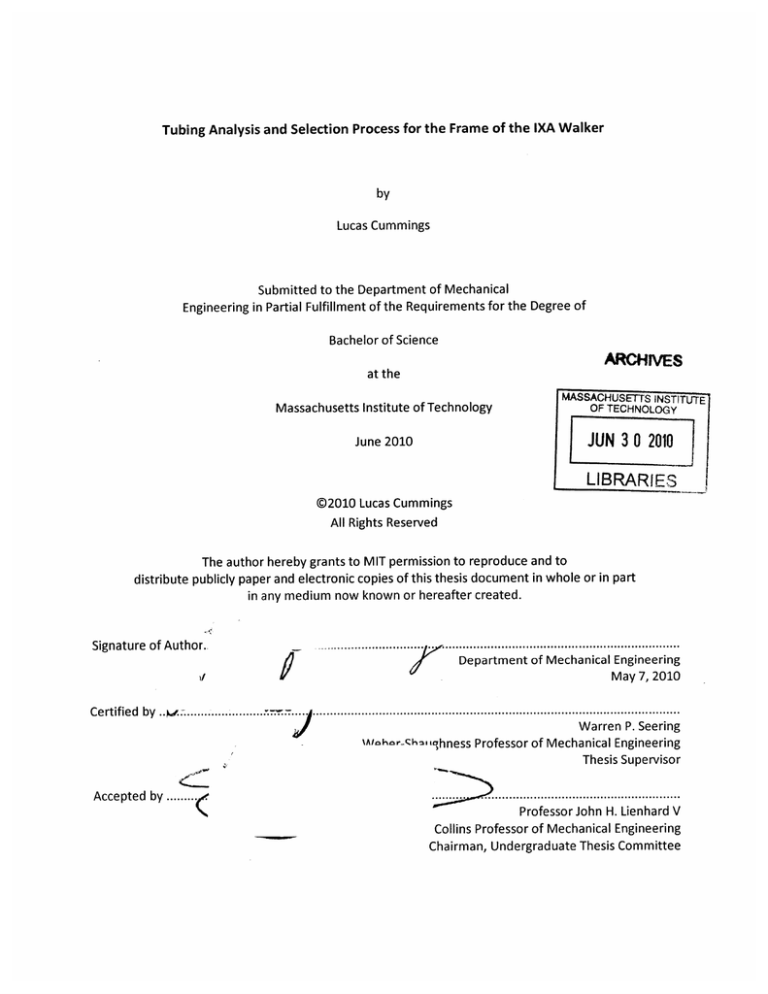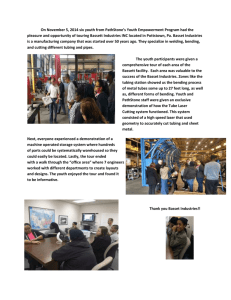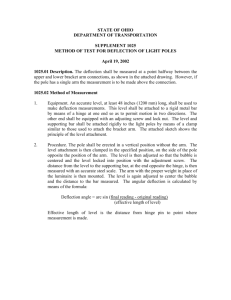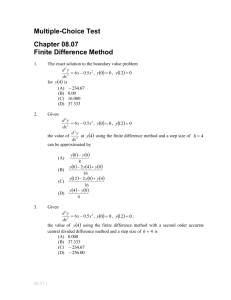
Tubing Analysis and Selection Process for the Frame of the IXA Walker
by
Lucas Cummings
Submitted to the Department of Mechanical
Engineering in Partial Fulfillment of the Requirements for the Degree of
Bachelor of Science
ARCHIVES
at the
Massachusetts Institute of Technology
MASS ACHUSETTSLINST ITUTEt
OF TECHNOLOGY
JUN 3 0 2010
June 2010
LIBRARIES
@2010 Lucas Cummings
All Rights Reserved
The author hereby grants to MIT permission to reproduce and to
distribute publicly paper and electronic copies of this thesis document in whole or in part
in any medium now known or hereafter created.
................. . . .........................----..--.
Signature of Author.
Department of Mechanical Engineering
I
Certified by ...
May 7,2010
- --...............................
woAhr-Cknhi
Accepted by .....
Warren P. Seering
'hness Professor of Mechanical Engineering
Thesis Supervisor
......
...
.
--.........--.
................................
..
---..
Professor John H. Lienhard V
of Mechanical Engineering
Professor
Collins
Chairman, Undergraduate Thesis Committee
Tubing Analysis and Selection Process for the Frame of the IXA Walker
by
Lucas Cummings
Submitted to the Department of Mechanical Engineering
On May 7 th, 2010 in Partial Fulfillment of the
Requirements for the Degree Bachelor of Science in
Mechanical Engineering
ABSTRACT
A thorough analysis and test of the frame for a walker was conducted in order to select the optimal size
tubing for the walker. Initially a rough first order bending analysis was completed to make an initial
decision on tubing size. Finite element analysis was done on the tubing selected to confirm the theory
of the first order analytical model, and to determine the expected deflection. A test rig was then built
with a 1:1 scale frame in order to test the actual deflection of the frame. Weights were used to measure
the deflection for masses varying from 0 lbs to 150 lbs. The results of the complete analysis and testing
show that a 1.5" outer diameter by 1.26" inner diameter tube will optimally meet the deflection and
weight requirements of the walker. The experimental results are within 5% error of the expected
deflection from the finite element analysis, while the quick first order analysis was within 7% of the
results from the finite element analysis.
Thesis Supervisor: Warren Seering
Title: Weber-Shaughness Professor of Mechanical Engineering
Acknowledgements
I would like to acknowledge the contributions of several key people who made this work
feasible: my thesis advisor, Prof. Warren Seering of the Department of Mechanical Engineering,
for helping and advising me as needed throughout the term; Prof. Alex Slocum, for working
with me early in the term and providing thoughtful and necessary feedback on the project; Eric
Sugalski, for the original idea of the IXA Walker design; and Prof. David Wallace, for inspiring
and guiding me through 2.009 where the walker concept originated and the original 2.009
Purple team from Fall 2009.
Table of Contents
Abstract
2
Acknowledgements
3
List of Tables and Figures
5
Introduction
6
Project Overview and Background
6
Original Frame Design Process
7
Frame Geometry
7
8
First Order Analytical Analysis
Purpose
8
Diagram of Simplified Frame
9
Bending Equations for Frame
10
Expected Results
11
12
Solid Modeling and FEA
Purpose
12
Results
13
15
Testing
Purpose
15
Testing Setup
15
Test Results
17
18
Conclusions and Recommendations
Discussion of Results
18
Tubing Selection
18
Recommendations and Further Work
18
4
List of Tables and Figures
Figures
Figure 1: Solid Model of IXA Walker
Figure 2: Side View of Walker in Up and Down Positions
Figure 3: Diagram of Simplified Frame
Figure 4: Simplified Frame Diagram Broken into 3 Cantilevered Beams
Figure 5: Dimensioned Drawing of Frame Used in FEA(all curves have 4" radii)
Figure 6: FEA Load Distribution
Figure 7: Displacement Distribution under 150 lbs
Figure 8: Picture of Aluminum Tubing After Bending
Figure 9: Experimental Setup
Figure 10: Plot of Deflection (cm) versus Weight (Ibs)
Tables
Table 1: Estimated Deflection of Framefrom
1s
Order Analysis in meters
Table 2: Estimated Weight of Frame fromist Order Analysis in lbs
Table 3: Comparison of FEA Analysis with First Order Analysis
Table 4: Comparison of Test Results versus FEA Theoretical Results
Introduction
Project Overview and Background
As an undergraduate mechanical engineering student at MIT you are required to take 2.009,
Product Development Engineering, in order to graduate. In teams of 15 students, you are tasked with
brainstorming and developing an alpha prototype of a product under a certain theme. For the fall of
2009 the theme was Emergency. After much deliberation and hard work our team built the alpha
prototype of the IXA Walker (figure 1), a walker designed to help users rise from any seated position
independently.
Figure 1: Solid Model of IXA Walker
There are two major modules of this design- the frame, made up almost entirely of aluminum
tubing, and the joint which connects the two parts of the frame. The joint allows the walker to rotate
from an upright walking position to a down position that is used to help the user rise independently
from any seated position. The handles in the down position act similarly to the way armrests on a chair
can be used when trying to stand up. This allows the user to help themselves up.
One major concern for the walker is the sturdiness and usability of the frame. According to our
market and user research, the frame must be able to withstand 300 lbs of force, deflect less than 1 cm
(only the deflection due to the frame bending, not the joint), and the total weight of the frames tubing
must be under 6 lbs in order to be competitive. This left us with tight constraints to work with.
Original Frame Design Process
The original frame design for the IXA Walker was haphazardly thrown together at the last
minute due to time constraints in the course.
We spent countless hours figuring out the perfect
geometry for the frame that would allow for the greatest variety in the size of the user, but neglected
doing the work on what type of tubing should be used in order to meet the requirements of our user
contract for force applied, deflection, and weight of the walker. Since nearly all other walkers were
made from a nearly standard 1" outer diameter 6061-T6 aluminum tubing, we assumed that would also
work for ours. This was a poor decision, since our walker was obviously not like any other walker.
Frame Geometry
The first prototype of our walker ended up having many design flaws. One of those flaws was
the design of the frame. This paper will describe the proper analysis needed for the design of a working
used to build a walker with the specified original geometry. Figure 2 shows a side view of the walker
with the original geometry. Since geometry was not an issue in the first prototype, the focus for
improvement of the frame was on the size of the tubing, not the shape of the frame.
Figure 2: Side View of Walker in Up and Down Positions
First Order Analytical Analysis
Purpose
The purpose of the first order analytical analysis is to gain a quick understanding of the frame.
From this analysis we expect to gain a rough idea of whether or not the project will succeed. This
analysis also provides a starting point for further in depth analysis and testing. Most importantly it saves
a significant amount of time and money.
Diagram of Simplified Frame
The walker will likely see the greatest stress from the user in the down position when the user
puts their full force on the walker in order to rise. It is important that the frame is able to withstand 300
lbs of total weight while not deflecting more than 1 cm in this position. Analyzing only the frame, a
simplified diagram can be made of the frame. This simplified diagram is made using the assumptions
that there will be some deflection and that there will not be any deflection along the lower rear leg that
is resting flat on the ground. The fact that there will not be any deflection in the lower leg allows us to
ignore it in the simplified diagram and model. The frame does not rotate around the point touching the
ground since the leg would be there to stop it, thus the deflection is only caused by bending. If there is
some deflection, then the front leg (with the wheel) will lift up and not receive any reaction forces since
it is not in contact with the ground. It is also important to note that the simplified diagram does not
include the curvature of the actual frame. The bending in the curvature can be assumed to be small in
comparison to the rest of the frame since it is a small proportion of the frame. Also the stress
concentrations introduced while bending the frame make it more difficult to bend. Figure 3 shows a
simplified diagram of the frame that will be used for the first order analytical analysis.
4, F
xF
Figure 3: Diagram of Simplified Frame
Using the concept of superposition this complex shape can be broken down into three separate
cantilevered beams in order to find the deflection. Figure 4 shows the simplified diagram broken down
into components with their respective reaction momments and forces.
F 4M
J
.
4
F
LM
I
Figure 4: Simplified Frame Diagram Broken into 3 Cantilevered Beams
Bending Equations for Frame
The total deflection of the frame is simply the sum of the deflections for the three different
cantilevered beams shown in figure 4.
This is a rough estimate of the upper bound of the actual
deflection (since not all deflections are in the downward direction). Equations 1,2,3 and 4 show the
resulting deflections, A, where F is the force applied by the person. The elastic modulus of the material
is E, and / is the moment of inertia.
=
FxF1
3
3EI
A2 =
Fx1 xi
2EI
+
F sin(49*)x 3
3EI
(1)
(2)
A3 =
F(x 1 +x 2 cos 41*)x3
F sin(17.5*)x
2EI
(3)
3EI
ATotalAl + A 2 +A 3
Expected Results
After inserting conservative values and a force of 682 N (150 lb.) into equation 4, spreadsheets
were used to determine which tubing sizes would be optimal for the frame.
Table 1 shows the
deflection in meters for various tube sizes. Table 2 shows the estimated weight for the frame for each
respective tube size.
The acceptable deflections(less than 1 cm) and weights(less the 6 lbs) are
highlighted in each table.
Outer Diameter (inches)
Deflection
(meters)
1.1
1.2
1.3
1.4
1.5
1.6
1.7
1.8
1 0.0477
1.1 N/A
0.0204
0.0354
0.0118
0.0163
0.0078
0.0092
0.0054
0.0061
0.0038
0.0044
0.0030
0.0031
0.0023
0.0024
0.0124
0.0222
0.0073
0.0099
0.0049
0.0058
0.0035
0.0039
0.0026
0.0029
0.0049
0.003
1.2
1.3
N/A
N/A
N/A
N/A
0.0286
N/A
1.4
N/A
N/A
N/A
N/A
0.0180
0.0080
1.5
N/A
N/A
N/A
N/A
N/A
0.0147 00670.0041
1.6
N/A
N/A
N/A
N/A
N/A
N/A
0.0121
1.7
N/A
N/A
N/A
N/A
N/A
N/A
N/A
Table 1: Estimated Deflection of Frame from 1 "tOrder Analysis in meters
0.0102
Outer Diameter (inches)
Weight(lbs)
1.1
1.2
1.6
3.36
1.3
1.4
1.5
5.31
7.3
9.5
1.1 N/A
1.6
1.7
1.8
11.9
14.4
17.1
7.9
10.3
12.8
15.5
6.2
8.6
11.1
13.8
6.6
9.2
11.8
7.1
9.8
N/A
N/A
1.3 N/A
N/A
N/A
1.4 N/A
N/A
N/A
N/A
1.5 N/A
N/A
N/A
N/A
N/A
1.6 N/A
N/A
N/A
N/A
N/A
N/A
N/A
N/A
N/A
N/A
N/A
N/A
1.2
1.7
7.6
2.4
N/A
Table 2: Estimated Weight of Frame from1st Order Analysis in lbs
Using the tables as a guide, and after checking with tubing suppliers for what size tubing is
readily available it was determined that tubing with an outer diameter of 1.5" and an inner diameter of
1.26" would best fulfill the requirements of the frame. The expected deflection of the frame made from
this tubing was 0.0075 meters with an estimated weight of 5.2 lbs. Once the first order analysis was
completed, it was time to verify the accuracy with a higher level model.
Solid Modeling and FEA
Purpose
The next step in the design process is to verify the first order model with a more accurate solid
model using SolidWorks and Finite Element Analysis (FEA). This is a quick and easy way to check your
work and verify that your model is at least fairly accurate and can also save you a significant amount of
time and money testing if you made a mistake in your original model.
Results
Figure 5 shows a dimensioned drawing of the frame used in the FEA. Figure 6 shows the load
distribution on the edges of the handle, split evenly between each face (75 lbs on each face for a total of
150 lbs). The model also used the properties of 2024 Al for the analysis since that was the type used in
testing.
Figure 5: Dimensioned Drawing of Frame Used in FEA(all curves have 4" radii)
Figure 6: FEA Load Distribution
13
Figure 7 shows the displacement distribution of the model for a 150 lbs load.
Figure 7: Displacement Distribution under 150 lbs
The Results of the FEA analysis compared to the first order analysis are shown in table 3. All the
results are for 1.5" outer diameter tubing with 1.26" inner diameter tubing since this is the size tubing
we are investigating.
Load(lbs)
Deflection (cm) of 1s order Analysis
Deflection (cm) of FEA
% Error
5
0.37
.0.6
75
0.37
0.36
2.8%
125
0.62
0.59
5.1%
Table 3: Comparison of FEA Analysis with First Order Analysis
The results of the FEA confirm the first order analytical model. All of the deflections are within
7%. It is important to note that these loading conditions assume only a vertical load. Horizontal loads
will slightly increase the deflection.
Testing
Purpose
The testing is designed to confirm both the first order analytical model and the solid model with
FEA. If the models do not agree with the test results, then they are worthless. This is the last step
before building another prototype. If the testing agrees, then we know we can use the models in order
to determine future changes in the design. This is the most costly and time consuming step in the
process but still saves a significant amount of time and money on your final prototype if there was an
error in both of the first models.
Testing Setup
The first step in the test setup was to bend the tubing to the appropriate dimensions of the
frame in the Pappalardo Laboratory. The tubing was bent using a hydraulic tube bending machine. A
picture of the bent 2024-T3 bare drawn aluminum tube is shown in figure 8.
Figure 8: Picture of Aluminum Tubing After Bending
15
The 2024-T3 aluminum was chosen for its qualities in bending. It has a much higher elongation at break
(18%) than other aluminum alloys which makes it easier to bend on the bending machine in lab. Other
aluminum alloys may have needed to be bent differently (using heating, or possibly filling with sand
before bending).
The bottom of the frame was then rigidly attached at the bottom to a piece of plywood so that
the frame did not rotate or tip. Weights were hung from the handle of the frame. A Vernier motion
sensor was used to measure the deflection of the frame under varying loads of up to 150 lbs. Tape was
used on the handles to better reflect the ultrasonic sound waves from the motion detector since it was
not consistently reflecting off the aluminum surface.
Figure 9 depicts the experimental setup.
Vernier motion detector
Tape to help the motion sensor detect
the frame
Aluminum frame
Weight hanging from the handle
Rigid support for frame
Figure 9: Experimental Setup
16
Test Results
The results of the test proved to be higher than expected at first glance, but this was due to the
fact that the frame was not bent to the exact dimensions described before and the weights were hung
slightly further back causing a larger bending moment on the frame. The results in table 4 reflect those
changes in dimensions in the FEA analysis.
Weight (lbs)
Deflection (cm) of test
Deflection (cm) of FEA
% Error
45
0.43
0.41
4.9 %
95
0.88
0.86
2.3 %
150
1.36
1i.35
0.7 %
Table 4: Comparison of Test Results versus FEA Theoretical Results
Also important to note, is the linearity of the deflection as weight increases up to 150 lbs. This
means that the tubing is only undergoing elastic deformation and not plastic deformation. A plot of the
experimental results is shown in figure 10.
1.6
- - -.--
1.4
- -.-.
1.2
S 0.8
06
.
K
-
- -
-
-
0.4
0
0
50
100
150
Weight (ibs)
Figure 10: Plot of Deflection (cm) versus Weight (Ibs)
17
200
Conclusions and Recommendations
Discussion of Results
The results of the testing show that, for the most part, the FEA accurately determined the
expected deflection of the tube to within 5%excluding the outlier (deflection for 25 lb. load). The first
order analysis gave a good starting point from which to move forward onto the FEA of the frame
without wasting considerable time on the FEA first. The deflection from the first order analysis ended
up being within 7% of the deflection from the FEA. The agreement between the first order analytical
model, the solid model/FEA, and the testing show that the models are accurate enough to use for the
selection of the tubing to be used in the frame.
Tubing Selection
Since the results of the test confirm the theoretical models, the tubing selection process has
already been done using the first order analytical model. Since we also do not have a factory where we
can draw aluminum tubing to our precise needs we are limited by what is currently available through
vendors. Thus, for the specified frame dimensions in figure 5, it would be best to use 1.5" tubing with
0.12" thick walls. This will yield an expected mass of approximately 10 lbs for the entire walker (5 lbs for
the frame) and a deflection of 0.75 cm under the maximum load of 300 lbs equally distributed on each
side of the frame. The rest of the walker's mass is made up of primarily the joint and some other
accessories. The frame would have a Factor of Safety (FoS) of 1.8 (from the FEA), meaning it could
handle a load of 540 lbs before deforming plastically.
This size tubing adequately meets the
requirements for - maximum load before failure, deflection, and weight of the frame.
Recommendations and Further Work
Although the round tubing is satisfactory for the current requirements, if the weight or the
deflection would need to be decreased, alternative designs would be necessary. Possible solutions that
could be further explored include; changing the geometry of the frame to something more likely to
handle the load by decreasing the moment, using either elliptical or different shaped tubing to take
advantage of the higher moment of inertia in the direction of bending, or possibly using gussets to
eliminate the bending around the curved portions of the frame.






